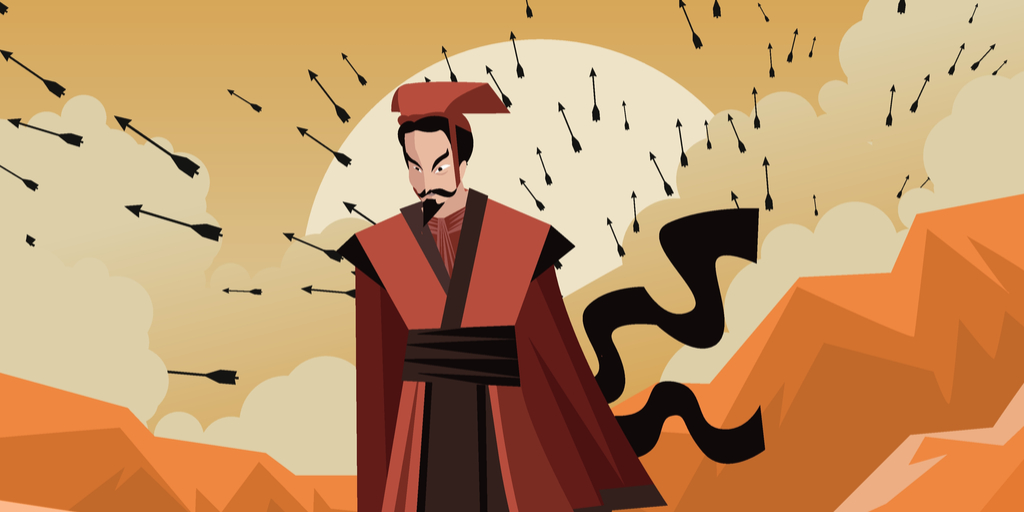
We’re an affiliate!
We hope you love the books we recommend! Just so you know, we may collect a share of sales or other compensation from the links on this page. Thank you very much if you use our links, we really appreciate it.
Long story short, “The Art of War” has documented the ultimate strategies and tactics that lead to victory in War. While it has many interpretations, many of the principles can relate to leadership situations in today’s world and how we can learn from War.
Whether we like it or not, War has been an intricate part of human history. Fortunately in today’s world, a lot of the wars we experience are not on the battlefield but instead, in business, politics and life.
The Art of War is a timeless classic as Sun Tzu covers several fundamental principles to be successful in winning any given battle or war.
While war is not completely removed from our world, the majority of the battles we face tend to be in workplace environments and political settings. Despite that being the case, the principles of War still remain relevant and applicable in those everyday settings.
Principles from the Art of War can teach various lessons on Leaderships in terms of:
- The significance of Preparation
- Educating the importance of Operations
- Utilizing Knowledge through Insiders
- Managing your Team
- Using the Environment to your Advantage
For those who don’t know
Sun Tzu is a famous military strategist and philosopher in the 6th century. He is most known for his works in the Art of War to illustrate the fundamental strategies and tactics used in War.
Significance of Preparation:
Winning a war is based on the planning and execution of a leader’s strategy. When it comes to carrying out this strategy, the first essential step is to prepare your goals to the conditions that were set.
What this means is that as you begin to prepare before the “battle” (also known as a business competiton, athletic event or political election), you must understand these conditions for yourself:
- The Way
- The alignment between the people and the cause or purpose
- Heaven
- The factors of the environment, temperature, geography,
- Market conditions
- Earth
- Positioning in relation to the enemy
- Where you stand in relation to the competition
- Leader
- Traits of leader which includes intelligence, integrity, confidence, discipline
- Law
- The ability of the authority to command the respect of its people
- Are they disciplined to the instructions provided
After determining these conditions, and understanding where you lie, it is equally as important to study your competitor under the same factors.
Suffering is an ineradicable part of life.
As you being to know you competitor as well as you know yourself, an evolutionary approach must be taken as the battle begins and the competition is set. This approach involves constantly navigating through moving parts and you continue to adapt your strategy to the changing factors in the environment.
Importance of Operations:
Something that is often overlooked and dismissed, the importance of operations in the battlefield is one of the deciding factors of any given outcome.
The importance of operations is based on your efficiency of supply chains and resourcefulness to make the most of what is available in the environment.
In war, operations mainly consisted of supply lines of ammunition, weapons and food, but in today’s world, it is composed of cash flows, natural resources and human resources.
Those who are the most efficient and wastes the least resources, gets the advantage here.
To best leverage operations in your strategy, you must be resourceful to not only be efficient and waste as little as possible, but to understand when an operation supply chain is too prolonged and is draining your resources. This can relate to situations where financial management comes into play in terms of investing to get the best return, and to understand when certain expenses are viewed as sunk costs.
A great example of this would be the fast-fashion model incorporated in today’s retail giants with Zara and H&M. These popular fashion chains have an unbeatable supply chain where they utilize economies of scale by outsourcing to cheap manufacturers to adapt to ever-evolving fashion trends.
Knowledge through Insiders:
One of the most essential aspects that will always be a competitive advantage is the power of Knowledge.
The more knowledge one obtains, the more powerful one becomes. This power comes from a deep understanding many elements of the landscape, as well as being aware of which factors you are ignorant of.
While it may seem malicious, the idea of using an insider against the competition is a common tactic. This is often used to get information that you were unable to obtain publicly.
Using insiders is a versatile tactic of getting an advantage in terms of not only obtaining more knowledge but providing false information, recruiting new human resources and making the competitors in the game more confused in the playing field.
These tactics are commonly used in political elections when supporters of opposite parties provide false or “politically correct” statements to confuse the public of who to actually vote for.
Those who are informed sooner, gain a slight edge.
Managing your team:
The strength and spirit of your people and community is determined by how you mobilize your human resources and how a leader manages themselves.
Mobilizing and leveraging your people would depend on the size of the team. If the size of the team small, it is easy to mobilize and move freely, however if the team is large, it is most optimal to subdivide them into smaller teams to make it easier to control movement.
The reason for opting for lean and mobile teams is to make communication seamless and to make decisions efficiently and effectively.
When it comes to leader managing a team, they are the most responsible for the decisions made on behalf of an organization’s people. When it comes to decision making, the best generals are aware to avoid these five faults:
- Impulsiveness
- Cannot go straight into a situation without knowing sufficient information
- Can lead to immediate failure
- Too hesitant
- Cannot be overly cautious and hesitant to make a decision
- Can lead to missing opportunities
- Quick temper
- Avoid getting irritated or provoked easily
- Can lead to embarrassment
- Inflexible
- Try not to be too tight or rigid in sticking to a specific plan or action
- Can lead to rebellious behaviour or lack of growth among your team
- Over-regard for the people
- Do not overly be concerned about your team
- Can lead to inconvenience or waste of time
Those who have the ability to make effective decisions and seamlessly communicate in teams effectively gets a one-up.
Understanding the Environment:
Despite the days of swords, shields and muskets being long overdue, that still does not change the fact that the understanding of any given environment in battle is vital to success.
Taking the idea of separating components for any given competitive landscape, and breaking down the each factor individually is still carried in today’s modern world.
You can apply this practice to any form of setting and understand where you can plan your strengths to attack your competition’s weaknesses and exploit them.
Here are a few examples where you can apply these practices:
- In Business
- The ability of solutions to solve certain problems
- Market supply & demand
- Emerging technologies and trends
- In Politics
- Positions on topics such as
- Health care
- Taxes
- Education
- Public satisfaction and opinion on certain policies
- Positions on topics such as
- Sports
- Offensive and defensive formations
- Weather and temperature
- Player and team matchups
Those who follow the first lesson in preparation can gain the best results when understanding the environment.
What can WE do from here?
These lessons of leadership drawn out from times of war had stood the test of time when it comes to understanding leadership, leveraging strengths and managing teams.
Since nowadays we are more active in participating in the battlefields of business, politics and life, we can still draw from these principles of war to lead our team to VICTORY.
If you would like to give Sun Tzu’s Art of War a read while supporting the blog feel free to click below:
Sources for this post:
#1: Mark, Joshua J. “Sun-Tzu.” Ancient History Encyclopedia, Ancient History Encyclopedia, 24 Feb. 2019, www.ancient.eu/Sun-Tzu/.
#2: Tzu, Sun. The Art of War, Sun Tzu. Simon & Brown, 2010.
#3: “What Is Fast Fashion?” Good On You, 11 Jan. 2019, goodonyou.eco/what-is-fast-fashion/.
#4: Boundless. “Boundless Political Science.” Lumen Learning, Lumen, courses.lumenlearning.com/boundless-politicalscience/chapter/the-modern-political-campaign/.






